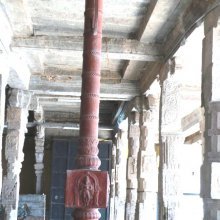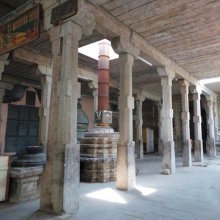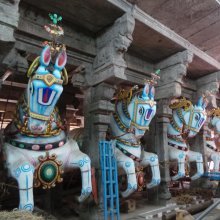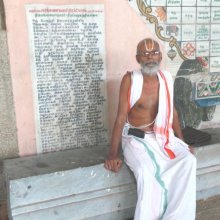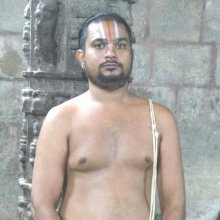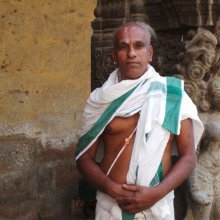Dhvaja, Dhvajā: 38 definitions
Introduction:
Dhvaja means something in Buddhism, Pali, Hinduism, Sanskrit, Jainism, Prakrit, the history of ancient India, Marathi, Hindi. If you want to know the exact meaning, history, etymology or English translation of this term then check out the descriptions on this page. Add your comment or reference to a book if you want to contribute to this summary article.
Alternative spellings of this word include Dhwaj.
Images (photo gallery)
In Hinduism
Shilpashastra (iconography)
Source: Google Books: The Theory of Citrasutras in Indian PaintingDhvaja (ध्वज, ‘flag’) is a weapon (āyudha or bādhra) according to the Vāstusūtra Upaniṣad.
Source: Red Zambala: Hindu Icons and Symbols | IntroductionDhvaja (flag) - Making oneself known to others, indicating that one is a source of charity and safety to all sentient beings. An indication of the triumph of the Dharma.

Shilpashastra (शिल्पशास्त्र, śilpaśāstra) represents the ancient Indian science (shastra) of creative arts (shilpa) such as sculpture, iconography and painting. Closely related to Vastushastra (architecture), they often share the same literature.
Shaivism (Shaiva philosophy)
Source: Wisdom Library: Kubjikāmata-tantraDhvaja (ध्वज, “banner”):—Fifth seat of the Svādhiṣṭhāna (2nd chakra), according to the Kubjikāmata-tantra. It is identified with the fifth of the seven worlds, named janaloka. Together, these seven seatsthey form the Brahmāṇḍa (cosmic egg). The Dhvaja seat points to the south-west.
The associated pura is called prakṛti, at the head of which is the Siddha named Khagīśa. These Siddhas are considered to have been the expounders of the kula doctrine in former times.
The associated dhātu (constituents of the physical body) is the Bones (asthi).
Source: Shodhganga: Temple management in the ĀgamasDhvaja (ध्वज) refers to one of the various Devatā weapons and represents a type of “temple implement (instrument)” as described in the Karaṇalakṣaṇavidhi-paṭala section of the Uttara-Kāmikāgama.—The instruments should be according to the particular śāstra followed at the temple. Some of the instruments mentioned are weapons of all Devatās including [viz., dhvaja].
Source: Brill: Śaivism and the Tantric TraditionsDhvaja (ध्वज) or Dhvajastambha refers to the “signpost” (of a pub), according to the Mattavilāsaprahasana.—Accordingly, as the Kāpālika cries out: “My darling, look. This pub resembles the Vedic sacrificial ground. For its signpost (dhvaja-stambha) resembles the sacrificial pillar (yūpa); in this case alcohol is the Soma, drunkards are the sacrificial priests, the wine glasses are the special cups for drinking Soma, the roasted meat and other appetizers are the fire oblations, the drunken babblings are the sacrificial formulae, the songs are the Sāman-hymns, the pitchers are the sacrificial ladles, thirst is the fire and the owner of the pub is the patron of the sacrifice”
Source: SOAS University of London: Protective Rites in the Netra TantraDhvaja (ध्वज) refers to the “flag (of royal initiation)”, according to the Svacchanda-tantra.—Accordingly, [verse 4.3-6, while describing the interpretation of dreams]—“In [auspicious] dreams [the dreamer] drinks wine, eats raw flesh, smears insect feces and sprinkles blood. He eats food of sour milk and smears a white garment. [He holds] a white umbrella over his head, decorates [himself] with a white garland or ribbon. [He sees] a throne, chariot or vehicle, the flag of royal initiation (dhvaja—dhvajaṃ rājyābhiṣecanam). He decorates [these things] with a coral, betel leaf fruit. [He also] sees Śrī or Sarasvatī”.

Shaiva (शैव, śaiva) or Shaivism (śaivism) represents a tradition of Hinduism worshiping Shiva as the supreme being. Closely related to Shaktism, Shaiva literature includes a range of scriptures, including Tantras, while the root of this tradition may be traced back to the ancient Vedas.
Dharmashastra (religious law)
Source: Wisdom Library: Dharma-śāstraDhvaja (ध्वज) refers to “that which marks a temple or such other places”. The word is used throughout Dharmaśāstra literature such as the Manusmṛti. (See the Manubhāṣya, verse 9.285)

Dharmashastra (धर्मशास्त्र, dharmaśāstra) contains the instructions (shastra) regarding religious conduct of livelihood (dharma), ceremonies, jurisprudence (study of law) and more. It is categorized as smriti, an important and authoritative selection of books dealing with the Hindu lifestyle.
Purana and Itihasa (epic history)
Source: archive.org: Shiva Purana - English Translation1) Dhvaja (ध्वज) refers to “flags” (suitable for great festivities), according to the Śivapurāṇa 2.3.37 (“The letter of betrothal is dispatched”).—Accordingly, as Himavat prepared the wedding of Menā and Śiva: “[...] Great festivities went on in the city. Banners, flags (dhvaja) and festoons shone everywhere. The canopies hid the sunlight. Himavat welcomed them with great delight and reverence. The mountains and the rivers, the gents and the ladies were duly received. He housed them suitably in separate places. They were gratified with the amenities provided by Himavat”.
2) Dhvaja (ध्वज) refers to the “flag staffs” (of a chariot), according to the Śivapurāṇa 2.5.8 (“The detailed description of the chariot etc.”).—Accordingly, as Sanatkumāra narrated to Vyāsa: “The divine chariot of lord Śiva consisting of all the worlds was built by Viśvakarman with devoted effort. [...] The firmament constituted the fender of the chariot; Heaven and salvation the flag staffs (dhvaja) [svargamokṣāvubhau dhvajau]; Abhṛamu (Abhramu?) and Kāmadhenu constituted its harrows at the end of the shafts. The unmanifest principle formed their shaft and cosmic intellect the chariot’s reeds. The cosmic Ego cosmic corners and elements its strength. [...]”.
Source: Cologne Digital Sanskrit Dictionaries: The Purana Index1a) Dhvaja (ध्वज).—Flag; of Śiva (bull)—of Lalitā with mahiṣa, mṛga and siṃha emblems:1 of Arjuna, Kārtavīrya.2 Vṛṣadakṣa, given by Surabhi.3
- 1) Brahmāṇḍa-purāṇa III. 3. 79; 27. 15; 49. 13; 55. 15; IV. 16. 35; 19. 84; 21. 8.
- 2) Matsya-purāṇa 43. 19; 44. 67; 257. 17; 281. 9.
- 3) Vāyu-purāṇa 66. 76; 94. 15.
1b) The 9th battle where Dhvaja was killed by Mahendra Viṣṇu.*
- * Brahmāṇḍa-purāṇa II. 72. 75; Vāyu-purāṇa 97. 75, 85.

The Purana (पुराण, purāṇas) refers to Sanskrit literature preserving ancient India’s vast cultural history, including historical legends, religious ceremonies, various arts and sciences. The eighteen mahapuranas total over 400,000 shlokas (metrical couplets) and date to at least several centuries BCE.
Natyashastra (theatrics and dramaturgy)
Source: Wisdom Library: Nāṭya-śāstraDhvaja (ध्वज) refers to a “banner-staff”, which is an accessories used in a dramatic play, according to Nāṭyaśāstra chapter 23. Such accessories and weapons should be made by experts using proper measurements and given to persons in their respective conditions. It forms a component of āhāryābhinaya (extraneous representation).

Natyashastra (नाट्यशास्त्र, nāṭyaśāstra) refers to both the ancient Indian tradition (shastra) of performing arts, (natya—theatrics, drama, dance, music), as well as the name of a Sanskrit work dealing with these subjects. It also teaches the rules for composing Dramatic plays (nataka), construction and performance of Theater, and Poetic works (kavya).
Vastushastra (architecture)
Source: Wisdom Library: Vāstu-śāstraDhvajā (ध्वजा, “mare”) refers to the first of eight yoni (womb), according to the Mānasāra. It is also known by the name Aśvā. Yoni is the fourth of the āyādiṣaḍvarga, or “six principles” that constitute the “horoscope” of an architectural or iconographic object. Their application is intended to “verify” the measurements of the architectural and iconographic object against the dictates of astrology that lay out the conditions of auspiciousness.
The particular yoni (e.g., dhvajā) of all architectural and iconographic objects (settlement, building, image) must be calculated and ascertained. This process is based on the principle of the remainder. An arithmetical formula to be used in each case is stipulated, which engages one of the basic dimensions of the object (breadth, length, or perimeter/circumference). The first, third, fifth and seventh yonis are considered auspicious and therefore to be preferred, and the rest, inauspicious and to be avoided.
Source: archive.org: Catalogue of Pancaratra Agama Texts (vastu)Dhvaja (ध्वज) refers to the “flag” (which requires certain installation-ceremonies), as discussed in chapter 44 of the Ādikāṇḍa of the Hayaśīrṣasaṃhitā: a large Pāñcarātra Āgama consisting of roughly 6500 verses dealing primarily with architecture, temple-building and consecration rituals and iconography.—Description of the chapter [dhvaja-pratiṣṭhā]: The flag-pole is made of wood but ornament on it of cakra, etc. may be made of stone, metal, etc. Details for making the flag-pole—which here seems to be a permanent fixture of the temple compound, and not a temporary thing replaced at each festival—are given. Also rules for its sanctification are given. [...]

Vastushastra (वास्तुशास्त्र, vāstuśāstra) refers to the ancient Indian science (shastra) of architecture (vastu), dealing with topics such architecture, sculpture, town-building, fort building and various other constructions. Vastu also deals with the philosophy of the architectural relation with the cosmic universe.
Ayurveda (science of life)
Source: gurumukhi.ru: Ayurveda glossary of termsDhvaja (ध्वज):—[dhvajam] Penis - The male organ of copulation and in mammals urination

Āyurveda (आयुर्वेद, ayurveda) is a branch of Indian science dealing with medicine, herbalism, taxology, anatomy, surgery, alchemy and related topics. Traditional practice of Āyurveda in ancient India dates back to at least the first millenium BC. Literature is commonly written in Sanskrit using various poetic metres.
Shaktism (Shakta philosophy)
Source: Google Books: ManthanabhairavatantramDhvaja (ध्वज) refers to “banners”, according to the Ṣaṭsāhasrasaṃhitā, an expansion of the Kubjikāmatatantra: the earliest popular and most authoritative Tantra of the Kubjikā cult.—Accordingly, “[...] O goddess, I will (now) tell you about the god of Kāmarūpa. (His) city is fashioned all around with pillars of sapphire. It has palaces, mansions, arches, banners, goads, and bows [i.e., prāsāda-toraṇa-aṭṭāla-dhvaja-aṅkuśa-dhanus-dhara]. The god holds five arrows and is accompanied by Kāmeśvarī. Without a body and in the form of light, he melts away the entire universe. He is the lord of the fourteen worlds and holds the staff (of authority). Everything, including passion and the rest, takes place impelled by his will. Thus, it is located in the foremost portion, above Mind Beyond Mind. O Pārvatī, one should meditate on it above the Cavity of Brahmā within the End of the Twelve”.

Shakta (शाक्त, śākta) or Shaktism (śāktism) represents a tradition of Hinduism where the Goddess (Devi) is revered and worshipped. Shakta literature includes a range of scriptures, including various Agamas and Tantras, although its roots may be traced back to the Vedas.
Jyotisha (astronomy and astrology)
Source: Wisdom Library: Brihat Samhita by Varahamihira1) Dhvaja (ध्वज) refers to a “(royal) flag staff”, according to the Bṛhatsaṃhitā (chapter 3), an encyclopedic Sanskrit work written by Varāhamihira mainly focusing on the science of ancient Indian astronomy astronomy (Jyotiṣa).—Accordingly, “The dark spots, also known as ketus, the sons of Rāhu are Tāmasa, Kīlaka and the like, and are 33 in number. How they affect the earth depends upon their color, position and shape. [...] If the solar spots should be of the shape of the emblems of royalty such as chatra (umbrella), dhvaja (flag staff) and cāmara (hairy fan) and the like, the reigning prince will be dethroned and a foreign prince will begin to reign. If the spots should appear like sparks of fire, like the smoke and the like, his subjects will suffer”.
2) Dhvaja (ध्वज) or Dhvajagiri refers to a mountain (range) belonging to “Pūrvā or Pūrvadeśa (eastern division)” classified under the constellations of Ārdrā, Punarvasu and Puṣya, according to the system of Kūrmavibhāga, according to the Bṛhatsaṃhitā (chapter 14).—Accordingly, “The countries of the Earth beginning from the centre of Bhāratavarṣa and going round the east, south-east, south, etc., are divided into 9 divisions corresponding to the 27 lunar asterisms at the rate of 3 for each division and beginning from Kṛttikā. The constellations of Ārdrā, Punarvasu and Puṣya represent the eastern division consisting of [i.e., Dhvaja] [...]”.

Jyotisha (ज्योतिष, jyotiṣa or jyotish) refers to ‘astronomy’ or “Vedic astrology” and represents the fifth of the six Vedangas (additional sciences to be studied along with the Vedas). Jyotisha concerns itself with the study and prediction of the movements of celestial bodies, in order to calculate the auspicious time for rituals and ceremonies.
Pancaratra (worship of Nārāyaṇa)
Source: archive.org: Catalogue of Pancaratra Agama Texts1) Dhvaja (ध्वज) refers to “Sudarśana’s banner”, as discussed in chapters 48-49 of the Ahirbudhnyasaṃhitā, a Pāñcarātra work in 60 chapters dealing with topics such as Viṣṇu’s discus-power, the processes of creation and esoteric practices related to Sudarśana (such as mantras and yantras).—Accordingly, Nārada asks if there is any less troublesome way to acquire the benign influence of Sudarśana’s power. Ahirbudhnya points out that, in fact, there have been kings who have achieved high power in other ways—namely [e.g., Citraśekhara with a “flag” (dhvaja)]. [...] Chapter 49 narrates the story of king Citraśekhara who was given a banner (dhvaja) with Sudarśana’s emblem on it by Mahālakṣmī and who henceforth went cut to conquer his adversaries without difficulty.
2) Dhvaja (ध्वज) or Dhvajamudrā refers to one of the Mudrās (gestures) discussed in chapter 31 of the Mārkaṇḍeyasaṃhitā: a Pāñcarātra text comprising some 2200 Sanskrit verses mainly dealing with temple-building, iconography, pūjā (worship procedures), utsava (festivities) and prāyaścitta (expiatory measures).—Description of chapter [mudrā-vidhāna]: As a part of worship [pūjāṅga], it is ordained in the śāstras that certain mudrā-gestures be done to please the gods (1). The ones listed and described are [e.g., Dhvaja-mudrā] [...]. When some of these are to be used in the worship of God is given (49b-58).
3) Dhvaja (ध्वज) or Dhvajamudrā refers to one of the 37 Mudrās (hand-gestures) described in chapter 7 of the Viṣṇusaṃhitā: a Sanskrit text written in 2600 verses which covers typical Pāñcarātra topics through a narrative dialogue between Aupagāyana and Siddha Sumati.—[Cf. the chapter mudrā-lakṣaṇa].
4) Dhvaja (ध्वज) or Dhvajamudrā refers to one of the 81 Mudrās (hand-gestures) described in chapter 2 of the Ṛṣirātra section of the Sanatkumārasaṃhitā: an encyclopedic Sanskrit text written in over 3500 verses dealing with a variety of topics such as yoga, temple-building, consecration ceremonies, initiation and dhanurveda (martial arts).—[Cf. the chapter mudrā-lakṣaṇa].

Pancaratra (पाञ्चरात्र, pāñcarātra) represents a tradition of Hinduism where Narayana is revered and worshipped. Closeley related to Vaishnavism, the Pancaratra literature includes various Agamas and tantras incorporating many Vaishnava philosophies.
General definition (in Hinduism)
Source: archive.org: Vedic index of Names and SubjectsDhvaja (ध्वज) occurs twice in the Rigveda in the sense of ‘banner’ used in battle. It is characteristic of Vedic fighting that in both passages reference is made to arrows being discharged and falling on the banners.
In Buddhism
Tibetan Buddhism (Vajrayana or tantric Buddhism)
Source: Wisdom Library: Tibetan BuddhismDhvaja (ध्वज) refers to one of the various Grahas and Mahāgrahas mentioned as attending the teachings in the 6th century Mañjuśrīmūlakalpa: one of the largest Kriyā Tantras devoted to Mañjuśrī (the Bodhisattva of wisdom) representing an encyclopedia of knowledge primarily concerned with ritualistic elements in Buddhism. The teachings in this text originate from Mañjuśrī and were taught to and by Buddha Śākyamuni in the presence of a large audience (including Dhvaja).
Source: Brill: Śaivism and the Tantric Traditions (tantric Buddhism)Dhvaja (ध्वज) refers to a “flagpole”, according to the Bhūśalyasūtrapātananimittavidhi section of Jagaddarpaṇa’s Ācāryakriyāsamuccaya, a text within Tantric Buddhism dealing with construction manual for monasteries etc.—Accordingly, “[...] If a parasol, lotus, banner, muraja drum, flagpole (dhvaja), ornament, a woman of the court, fish, milk, the best curd, wine, blazing fire, and fruits [are seen], then there are victory, extraordinary increase of grain, property, [the number of] sons, and other [merits], and the completion of duties. [...]”.
Source: OSU Press: Cakrasamvara SamadhiDhvaja (ध्वज) refers to a “banner”, according to the Guru-maṇḍala-arcana [i.e., “Guru Mandala Worship]” ritual often performed in combination with the Cakrasaṃvara Samādhi, which refers to the primary pūjā and sādhanā practice of Newah Mahāyāna-Vajrayāna Buddhists in Nepal.—Accordingly, “By the form of a skull cup, and by the letter Māṃ, Vāruṇī, Eighteen arms, one face, red color, and three eyes, A sword, arrow and hook, on the right, a skull cup, ax and banner (dhvaja), Thus a mace, thus a bell, and in the ninth, granting wishes, A two-headed drum, a bow and noose, a staff and a water pot, A trident, hammer and lute, and thus a number, in the upper hand, A young adolescent beauty, a great beauty, a beautiful goddess”.

Tibetan Buddhism includes schools such as Nyingma, Kadampa, Kagyu and Gelug. Their primary canon of literature is divided in two broad categories: The Kangyur, which consists of Buddha’s words, and the Tengyur, which includes commentaries from various sources. Esotericism and tantra techniques (vajrayāna) are collected indepently.
Mahayana (major branch of Buddhism)
Source: academia.edu: A Study and Translation of the GaganagañjaparipṛcchāDhvaja (ध्वज) refers to “(showering) banners”, according to the Gaganagañjaparipṛcchā: the eighth chapter of the Mahāsaṃnipāta (a collection of Mahāyāna Buddhist Sūtras).—Accordingly, “[...] Then, by the unconditioned magical power of manifestation, by the miraculous performances (vikrīḍita) of the Buddha [Ekaratnavyūha], [Gaganagañja with the other Bodhisattvas] teleported from the Mahāvyūha universe to the Sahā universe, in one moment of thought, and sat down there. They showered flowers, garlands, powders, perfumes, unguents, parasols, banners (dhvaja), flags from the Mahāvyūha universe pouring down as rain”

Mahayana (महायान, mahāyāna) is a major branch of Buddhism focusing on the path of a Bodhisattva (spiritual aspirants/ enlightened beings). Extant literature is vast and primarely composed in the Sanskrit language. There are many sūtras of which some of the earliest are the various Prajñāpāramitā sūtras.
General definition (in Buddhism)
Source: WikiPedia: BuddhismOne of the Eight Auspicious Symbols; Dhvaja (Skt. also Dhwaja; Tib. rgyal msthan), meaning banner or flag. Dhvaja banner was a military standard of ancient Indian warfare. Makara Dhvaja has become latter an emblem of the Vedic god of love and desire - Kamadeva. Within the Tibetan tradition a list of eleven different forms of the victory banner is given to represent eleven specific methods for overcoming defilements. Many variations of the dhvajas design can be seen on the roofs of Tibetan monasteries to symbolyze the Buddhas victory over four maras.
In Jainism
General definition (in Jainism)
Source: Shodhganga: A cultural study on the jain western Indian illustrated manuscriptsDhvaja (ध्वज, “flag”).—The eighth of “fourteen dreams” of Triśalā.—The eighth dream manifested as the flag fluttering on the top of a golden staff comprising of sober colors such as blue, red, yellow and gold, it’s hoisting caused sounds like the roar of a lion.

Jainism is an Indian religion of Dharma whose doctrine revolves around harmlessness (ahimsa) towards every living being. The two major branches (Digambara and Svetambara) of Jainism stimulate self-control (or, shramana, ‘self-reliance’) and spiritual development through a path of peace for the soul to progess to the ultimate goal.
India history and geography
Source: Cologne Digital Sanskrit Dictionaries: Indian Epigraphical GlossaryDhvaja.—(CII 3), banner or standard as distinguished from lāñchana or crest. Cf. cihna (Ep. Ind., Vol. XXXIV, pp. 135 ff.). Note: dhvaja is defined in the “Indian epigraphical glossary” as it can be found on ancient inscriptions commonly written in Sanskrit, Prakrit or Dravidian languages.

The history of India traces the identification of countries, villages, towns and other regions of India, as well as mythology, zoology, royal dynasties, rulers, tribes, local festivities and traditions and regional languages. Ancient India enjoyed religious freedom and encourages the path of Dharma, a concept common to Buddhism, Hinduism, and Jainism.
Languages of India and abroad
Marathi-English dictionary
Source: DDSA: The Molesworth Marathi and English Dictionarydhvaja (ध्वज).—m (S) pop. dhvajā f A flag, an ensign, a banner. dhvaja lāvaṇēṃ To signalize one's self by feats of valor, display of learning &c.: also to become infamously notorious.
Source: DDSA: The Aryabhusan school dictionary, Marathi-Englishdhvaja (ध्वज).—m dhvajā f A flag, an ensign, a ban- ner. dhvaja lāvaṇēṃ To signalize one's self by feats of valour, display of learn- ing &c.; to become infamously noto- rious.
Marathi is an Indo-European language having over 70 million native speakers people in (predominantly) Maharashtra India. Marathi, like many other Indo-Aryan languages, evolved from early forms of Prakrit, which itself is a subset of Sanskrit, one of the most ancient languages of the world.
Sanskrit dictionary
Source: DDSA: The practical Sanskrit-English dictionaryDhvaja (ध्वज).—[dhvaj-ac]
1) A flag, banner, standard, ensign; R.7.4;17.32; आरोहति न यः स्वस्य वंशस्याग्रे ध्वजो यथा (ārohati na yaḥ svasya vaṃśasyāgre dhvajo yathā) Pañcatantra (Bombay) 1.26; ध्वजं चक्रे च भगवानुपरि स्थास्यतीति तम् (dhvajaṃ cakre ca bhagavānupari sthāsyatīti tam) Mb.
2) A distinguished or eminent person, the flag or ornament (at the end of comp.); as in कुलध्वजः (kuladhvajaḥ) 'the head, ornament, or distinguished person of a family'.
3) A flagstaff.
4) A mark, emblem, sign, a symbol; वृषभ°, मकर° (vṛṣabha°, makara°) &c.
5) the attribute of a deity.
6) The sign of a tavern.
7) The sign of a trade, any trademark.
8) The organ of generation (of any animal, male or female).
9) One who prepares and sells liquors; Manusmṛti 4.85; सुरापाने सुराध्वजः (surāpāne surādhvajaḥ) Ms.
1) A house situated to the east of any object.
11) Pride.
12) Hypocrisy.
13) A skull carried on a staff (as a mark of ascetics) or as a penance for the murder of a Brāhmaṇa; see खट्वाङ्ग (khaṭvāṅga).
14) (In prosody) An iambic foot. (dhvajīkṛ to hoist a flag; (fig.) to use as a plea or pretext.)
15) part of a sword; श्रेष्ठखड्गाङ्गयोरपि (śreṣṭhakhaḍgāṅgayorapi) Nm.
Derivable forms: dhvajaḥ (ध्वजः).
Source: Cologne Digital Sanskrit Dictionaries: Shabda-Sagara Sanskrit-English DictionaryDhvaja (ध्वज).—mn.
(-jaḥ-jaṃ) 1. A flag or banner. 2. A mark, a sign or symbol. 3. The penis. 4. The upper part of a skull carried on a stick, as a penance for the murder of a Brahman. 5. A house situated to the east of any object. 6. A flag-staff. 7. (In Prosody,) An Iambic. m.
(-jaḥ) 1. A distiller. 2. Pride. 3. Hypocrisy, fraud. E. dhvaja to go, affix ac .
Source: Cologne Digital Sanskrit Dictionaries: Benfey Sanskrit-English DictionaryDhvaja (ध्वज).—m. and n. 1. A flag or banner, [Rāmāyaṇa] 2, 67, 26. 2. A mark, a symbol, Mahābhārata 1, 1511. 3. A distiller’s fiag, Man 4, 85. 4. The penis, [Suśruta] 2, 114, 9.
Source: Cologne Digital Sanskrit Dictionaries: Cappeller Sanskrit-English DictionaryDhvaja (ध्वज).—[masculine] ([neuter]) banner, standard, flag, sign of any trade, mark, emblem, symbol, characteristic; the ornament of (—°).
Source: Cologne Digital Sanskrit Dictionaries: Monier-Williams Sanskrit-English Dictionary1) Dhvaja (ध्वज):—[from dhvañj] m. (n. only, [Harivaṃśa 9245] and [gana] ardharcādi; [from] 2. dhvaj) a banner, flag, standard (ifc. f(ā). ), [Ṛg-veda] etc. etc.
2) [v.s. ...] a flag-staff, [Horace H. Wilson]
3) [v.s. ...] mark, emblem, ensign, characteristic, sign, [Mahābhārata; Harivaṃśa]
4) [v.s. ...] attribute of a deity (cf. makara-, vṛṣabhaetc.)
5) [v.s. ...] the sign of any trade ([especially] of a distillery or tavern) and the business there carried on [Manu-smṛti iv, 85]
6) [v.s. ...] a distiller or vendor of spirituous liquors, [cf. Lexicographers, esp. such as amarasiṃha, halāyudha, hemacandra, etc.]
7) [v.s. ...] (ifc.) the ornament of (e.g. kula-dhvaja), [cf. Lexicographers, esp. such as amarasiṃha, halāyudha, hemacandra, etc.]
8) [v.s. ...] the organ of generation (of any animal, male or female), [Suśruta; cf. Lexicographers, esp. such as amarasiṃha, halāyudha, hemacandra, etc.] (cf. puṃ-, strī-)
9) [v.s. ...] a skull carried on a staff (as a penance for the murder of a Brāhman, [Horace H. Wilson]; as a mark of ascetics and Yogīs, [Monier-Williams’ Sanskrit-English Dictionary])
10) [v.s. ...] Name of a tree (= -vṛkṣa), [Catalogue(s)]
11) [v.s. ...] a place prepared in a peculiar way for building, [cf. Lexicographers, esp. such as amarasiṃha, halāyudha, hemacandra, etc.] (in pros.) an iambic
12) [v.s. ...] (in [grammar]) a [particular] kind of Krama-pāṭha
13) [v.s. ...] (in [astrology]) Name of a Yoga
14) [v.s. ...] pride, arrogance, hypocrisy, [cf. Lexicographers, esp. such as amarasiṃha, halāyudha, hemacandra, etc.]
15) [v.s. ...] Name of a Grāma, [Pāṇini 4-2, 109 [Scholiast or Commentator]]
Source: Cologne Digital Sanskrit Dictionaries: Yates Sanskrit-English DictionaryDhvaja (ध्वज):—[(jaḥ-jaṃ) m. n.] A flag, a banner, a mark; a flag-staff; a skull carried on a stick for penance; an iambic; penis. m. A distiller; pride; fraud, hypocrisy.
Source: DDSA: Paia-sadda-mahannavo; a comprehensive Prakrit Hindi dictionary (S)Dhvaja (ध्वज) in the Sanskrit language is related to the Prakrit words: Jhaya, Dhaya.
[Sanskrit to German]
Sanskrit, also spelled संस्कृतम् (saṃskṛtam), is an ancient language of India commonly seen as the grandmother of the Indo-European language family (even English!). Closely allied with Prakrit and Pali, Sanskrit is more exhaustive in both grammar and terms and has the most extensive collection of literature in the world, greatly surpassing its sister-languages Greek and Latin.
Hindi dictionary
Source: DDSA: A practical Hindi-English dictionary1) Dhvaja (ध्वज) [Also spelled dhwaj]:—(nm) a flag, banner, ensign, colours; -[daṃḍa] a flagstaff; -[pota] a flagship.
2) Dhvajā (ध्वजा) [Also spelled dhwaja]:—(nf) a flag, standard, ensign, banner; colours; ~[dhārī] a standard-bearer; ~[ropaṇa] implantation of a flag; ~[rohaṇa] hoisting of a flag.
...
Kannada-English dictionary
Source: Alar: Kannada-English corpusDhvaja (ಧ್ವಜ):—
1) [noun] a piece of cloth or bunting, often attached to a staff, with distinctive colours, patterns or symbolic devices, used as a national or state symbol, as a signal, etc.; banner; a flag; standard.
2) [noun] an object used to represent something; a symbol.
3) [noun] the organ of copulation and of urinary excretion in men; the penis.
4) [noun] a foretelling the prosperity of a person living in a house, based on the remainder got by dividing the area of the site of the building by 8.
5) [noun] ಧ್ವಜ ಹಾರಿಸು [dhvaja harisu] dhvaja hārisu to hoist a flag; 2. (fig.) to become victorious.
Kannada is a Dravidian language (as opposed to the Indo-European language family) mainly spoken in the southwestern region of India.
Nepali dictionary
Source: unoes: Nepali-English DictionaryDhvaja (ध्वज):—n. 1. flag; banner; standard; 2. symbol; emblem; 3. penis; 4. chief;
Nepali is the primary language of the Nepalese people counting almost 20 million native speakers. The country of Nepal is situated in the Himalaya mountain range to the north of India.
See also (Relevant definitions)
Starts with (+18): Dhvajabaddhaka, Dhvajabhanga, Dhvajabhumi, Dhvajacapa, Dhvajadanda, Dhvajadruma, Dhvajagra, Dhvajagriha, Dhvajagriva, Dhvajahrita, Dhvajamala, Dhvajamshuka, Dhvajamudre, Dhvajanavami, Dhvajapata, Dhvajapatakin, Dhvajapraharana, Dhvajarajin, Dhvajaroha, Dhvajarohana.
Query error!
Full-text (+413): Vrishadhvaja, Taladhvaja, Makaradhvaja, Vrishabhadhvaja, Garudadhvaja, Ritadhvaja, Dhvajarohana, Dhvajapata, Smaradhvaja, Dhumadhvaja, Kushadhvaja, Kapidhvaja, Barhidhvaja, Tarkshyadhvaja, Dharmadhvaja, Suradhvaja, Dhvajabhanga, Dhvajadruma, Mahishadhvaja, Trinadhvaja.
Relevant text
Search found 75 books and stories containing Dhvaja, Dhvajā; (plurals include: Dhvajas, Dhvajās). You can also click to the full overview containing English textual excerpts. Below are direct links for the most relevant articles:
Garga Samhita (English) (by Danavir Goswami)
Verse 8.13.123 < [Chapter 13 - A Thousand Names of Lord Balarāma]
Verse 1.3.21 < [Chapter 3 - Description of the Lord’s Appearance]
Verse 4.7.25 < [Chapter 7 - The Story of the Ayodhya Women]
Bhagavad-gita (with Vaishnava commentaries) (by Narayana Gosvami)
Verse 1.20 < [Chapter 1 - Sainya-Darśana (Observing the Armies)]
Sahitya-kaumudi by Baladeva Vidyabhushana (by Gaurapada Dāsa)
Brihad Bhagavatamrita (commentary) (by Śrī Śrīmad Bhaktivedānta Nārāyana Gosvāmī Mahārāja)
Verse 1.4.87 < [Chapter 4 - Bhakta (the devotee)]
Verse 1.4.65 < [Chapter 4 - Bhakta (the devotee)]
Isanasivagurudeva Paddhati (study) (by J. P. Prajith)
11. Description of Pratishtha-vidhi (installation rites) < [Chapter 4 - Worship of Gods and Goddesses]
20. An assortment Sanskrit works on Tantra < [Chapter 1 - History and scope of Tantric Literature]
12. Description of Nityotsava-vidhi (festival rites) < [Chapter 4 - Worship of Gods and Goddesses]
Agni Purana (by N. Gangadharan)
Related products
